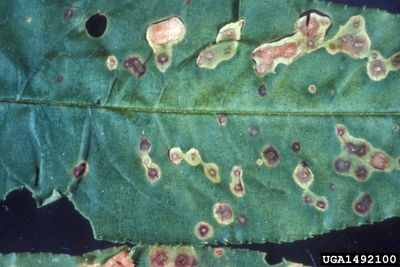What Causes Cherry Black Leaf Spot?
Cherry black leaf spot is a disease caused by the bacterium Xanthomonas arboricola var. pruni, also sometimes referred to as Xanthomonas pruni. It affects only stone fruits, and while it is most common on plums, nectarines, and peaches, it is also known to affect cherry trees.
Symptoms of Shot Hole Disease on Cherries
Cherry trees that fall victim to black leaf spot first exhibit symptoms as small, irregularly shaped spots of pale green or yellow on the undersides of leaves. These spots soon bleed through to the upper side and darken to brown, then black. Eventually, the diseased area falls out, earning the disease the name “shot hole.” There may still be a ring of affected tissue around the hole. Often, these spots cluster around the leaf tip. If the symptoms become severe, the whole leaf will drop from the tree. Stems may also develop cankers. If the tree becomes infected early in the growing season, fruit may develop in strange, distorted shapes.
Preventing Black Leaf Spot on Cherry Trees
Though the symptoms may sound bad, cherry shot hole is not a very serious disease. This is good news, because there does not yet exist an effective chemical or antibacterial control. The best method of prevention is to plant trees that are resistant to the bacterium. It’s also a good idea to keep your cherry trees well fertilized and watered, because a stressed tree is always more likely to succumb to a disease. Even if you do see signs of infection, however, it’s not the end of the world.
